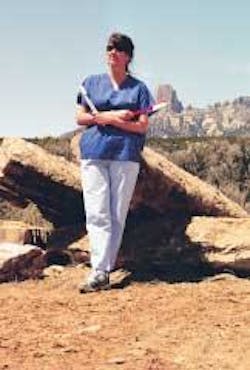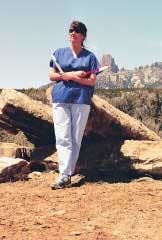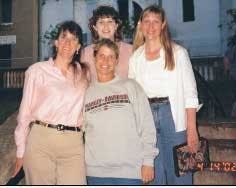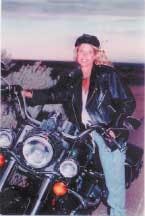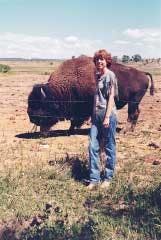IHS A great place to start ... and stay
by Joanne Iannone Sheehan, RDH
They make their way from Ketchikan, Alaska; Isleta, N.M.; and Onamia, Minn. They travel over deserts, plains, and mountains to come together. It is said that their powwow lasts for days. They speak of news, trade ideas, and learn from one wiser than they. Their nights are full of voices and laughter, for each has a story to tell. When the time has come, they return to their homes and their people, saying, "Well, that was fun; I earned my CE hours, and I had a blast doing it! I love networking with other hygienists!"
COLORADO
Tammy Honold, RDH, of Ignacio, Colo., contacted RDH with a story idea. Her topic highlighted a branch of the Public Health System that few are familiar with — Indian Health Services (IHS). The challenges of a career in the IHS are surpassed only by the benefits. A hygienist definitely can feel needed in this organization. Opportunities for personal and professional growth are just part of what makes the IHS so attractive.
Honold, working toward her bachelor's degree and an MPH, has already written proposals for two programs: diabetes mellitus and tobacco cessation. Tobacco is the number one killer in the Native American population.
When Honold wrote to RDH, she was gearing up for the National Indian Health Services Dental Hygiene Updates Meeting in San Antonio, Texas, April 15-19.
"This biannual event gets all the RDHs from the IHS together to update us on what is new. This year's meeting will be very interesting since the 1999 Oral Health Survey results just came out and the decay rate in Indian country has not improved in the last eight years. We have the worst decay rate at approximately 75 percent! This report will open a lot of doors for us to expand our public health initiatives. We will discuss many things at this meeting as well as public health programs," Honold said. "We are a unique group of RDHs. Many of us live in the most extreme, remote areas of the country.
"We are faced with very unique challenges. IHS RDHs meet biannually at a national meeting (dentists, hygienists, and assistants combined). But once every two years just the hygienists are given the chance to let off some steam, network, and take continuing-education classes together."
The IHS employs hygienists in 35 states to treat patients in more than 200 clinics. Today, more than one million American Indians and Alaskan natives are served by the IHS and Tribal Programs.
"I have lived in Durango, Colo., for 18 years," Honold said. "I began with IHS in 1998. I have always worked in the Ignacio clinic until recently, when I began a diabetic program at our sister clinic in Towaoc, Colo., about an hour-and-a-half commute from here at the base of the Sleeping Ute mountain (home of the Ute tribe). Thursdays are DM Day ( diabetes mellitus) in Tawaoc.
"In a full medical clinic, I screen patients in the morning, then treat perio patients in the afternoon. I'm also involved with the Well Child Program in Ignacio. During a child's immunization visit, I come into the treatment room and perform an oral screening, apply fluoride varnish, share oral hygiene instructions, and counsel the caregiver on nutrition. This is a great way to introduce young patients to dentistry and the dental staff without the fear of the dental clinic. I am also involved with our 'Lasso Tobacco' coalition, conducting training sessions for many health-care providers in Durango."
What career opportunities would a hygienist with an associate's degree find in the IHS?
"Most hygienists with an associate's degree work in a tribal hire position," Honold explained. "But they can also work as a federal contractor like I do. I'm required to take various training courses from bioterrorism to women's abuse issues. But I find this all very interesting.
"My benefits include flexibility to conduct my tobacco programs. Currently, 'tobacco' is not yet on my job description, so I do it in my spare time. My mission is to train all clinics to incorporate information on tobacco use into all patient appointments ... like a vital sign!" she told me.
How did Honold begin with IHS?
"I started in IHS because a friend was transferring from a clinic eight miles from where I live. She talked to me for months about it, but I was scared. I heard somewhere that IHS was tough and hygienists were unappreciated. Plus, with the culture difference, I wasn't sure I would be accepted.
"They are Southern Ute. I am English, Russian, Cherokee, Choctaw. But after I took the job, my fears disappeared in five minutes. The patients are like any other patients. If you treat them with respect, they respond with respect. Perhaps it takes a bit more patience, because many of our patients are dealing with other issues in their lives. They can't be nagged, but will listen to caring, concerned advice. I started working one day a week, but it's grown to full-time. I'm at two clinics now."
NEW MEXICO
Christine Murphy, RDH, started working for the Pueblo of Isleta in January 1998 in a Tribal Run Program (or 638). This program is managed by the tribe using government funds. Isleta is south of Albuquerque, N.M., right in the heart of the Rio Grande Valley. She said flexibility is what makes her job better than working in a private practice.
"Where do I start? For the most part, the people here are so appreciative of the care they receive at our clinic. As far as the treatment I can provide, it is based solely on the patient. I love the lack of restrictions regarding patient care. I don't have to worry about production, time, or anything else. If the patient needs four quads of scaling and root planing, I don't have to worry about whether or not they can afford it. If I need 60 minutes with a patient, that's what I schedule. If I was not quite finished with fine scaling, I just bring them back.
"There are so many aspects of the position that I love," Murphy continued. "I do many community-oriented projects, including educating the teachers at Head Start and the elementary school.
"Our clinic is multidisciplinary. We work with the diabetes program, WIC, Head Start, the elderly center, and we're in the same building as the health program for the Pueblo. We have put on health fairs in conjunction with the health clinic and diabetes program. My clinic is so stress-free. Everyday I wake up happy to go to work. In private practice that was not the case, and I worked in private practice for 20 years."
Murphy was named interim director for the Pueblo of Isleta in April 1999 and assisted the Tribal Council in hiring a dentist. Still, she confessed she was afraid of not being up to the task. She was informed on a Thursday that she would have to appear before the Tribal Council on Monday.
Her intimidation was short-lived when the council passed her budget, six months later naming her permanent director in October 1999. Murphy has the distinction of being the only hygienist in the nation who is clinic chief (director) in a clinic with a full-time dentist present.
"Currently, we provide dental service to about 5,000 Isleta tribal members. I supervise one full-time dentist, four contract dentists, an oral surgeon, a pedodontist, a prosthodontist, four dental assistants, and I am in the process of hiring a hygienist. I work clinically three days a week, and I have one day of administrative work," she told me.
Another way one can work for Indian Health Services is through the Commissioned Corps (CC) of the U.S. Public Health Service, one of the best-kept secrets around. It very much resembles the military with its benefits, pay raises, and uniforms, but CC dental professionals engage in combat that involves fighting caries and periodontal disease.
Another way the CC differs from the military is that a health professional has a lot more input as to where she or he lives and works and for how long. The pay is great, and the work is challenging and rewarding, with job security a big plus.
For hygienists who are tired of the same daily drudgery, feeling unappreciated and bogged down with the commercialism of dentistry, the Commissioned Corps may be the answer. It provides the satisfaction of knowing you are needed, appreciated, and respected as a health professional, with no pressure to "sell" products or services to patients.
At the end of the day, these hygienists know they've made a difference in many lives doing what they were trained to do.
OREGON
Beth Finnson, RDH, MPH, at the Chemawa Indian Health Center in Salem, Ore., is an officer in the Commissioned Corps.
"We are extremely dedicated to our jobs and our patients. I'm very impressed with the caliber of hygienists I've met in the Indian Health Service. I look forward to our yearly meetings for networking, bonding, continuing education, and friendship. I can't talk about my job with my private-practice friends; it's just too different — much more satisfying. I like my job because I am providing health care and education to people who may not have any other options for health care. I figure I can always find a job just scaling teeth somewhere, but never a career as fulfilling as this one," Finnson said.
The Chemawa Indian Health Center is an urban health facility on federal land adjacent to the 100-year-old Chemawa Indian School building.
The dental clinic — consisting of two dentists, three assistants, a receptionist, and Finnson — treats Native Americans in federally recognized tribes from southern Washington to southern Oregon. Finnson practices in a former dentist's office attached to the regular dental clinic. She likes the relative quiet, being slightly separated from constant clinic activity. Her equipment is not more than 10 years old, and she just received a brand-new ultrasonic scaler.
Finnson admitted they are woefully understaffed. Their ever-increasing patient base receives 30 to 40 new patients a month. Because of the overwhelming demand on their resources, the clinic focuses care on target groups having the most health problems: Chemawa Indian School students, diabetics, Head Start and preschool children, and high-risk caries and perio patients. The clinic provides basic dental health care, while keeping crowns, bridges, partials, and dentures to a minimum.
"We are fortunate to be able to hire specialists part-time to help out — endodontists, pedodontists, periodontists, and oral surgeons. But we are never caught up with our workload," Finnson said.
The Chemawa Indian Health Center is the only health care available for some of these patients who lack health insurance or who have lost health benefits due to retirement. Most patients appreciate the services offered, and many have been there for years. Finnson's dental team treats three, four, and even five generations of the same families. Because appointments are hard to get, most patients keep them.
"Since 1991, I've been a commissioned officer in the U.S. Public Health Service practicing at Chemawa," Finnson told me. "When I was a dental hygiene student at Oregon Health Sciences University in Portland, Ore., (she graduated in 1990) we were sent to Chemawa for a clinical rotation. Our instructor, Jill Mason, had worked part-time at Chemawa many years before and thought we needed more of a public health perspective in our dental hygiene education. The Public Health Service started hiring hygienists in 1991, and I got a call from the dentist at Chemawa asking if I was interested. I wasn't satisfied with private practice, so I decided to give it a try. And I'm still here because I like it. The salary and benefits for Commission Corps people is a large part of why I like the system. It's a career, not just a job. I was 40 when I graduated from OHSU, and this is a good, secure system for me to support myself and plan for retirement. I was already in Oregon with my family when this job opportunity came up, so it was my first and only choice. I just slid right into the system."
MARYLAND
Candace Jones, RDH, MPH, is the highest-ranking hygienist in the IHS. She works at the headquarters operations in Rockville, Md. She had been practicing hygiene for 16 years before she moved to Anchorage, Alaska. Since there were no job opportunities in the private sector, she became interested in the IHS at the suggestion of a friend. In 1985, she left private practice and contracted with IHS, working part-time in administration and part-time at the Alaska Native Medical Center dental clinic. She fell in love with public health; it changed her life.
In 1987, Jones enrolled at the University of Michigan and earned her master's degree in public health. At that time, a master's degree was required to be eligible for the U.S. Public Health Service Commissioned Corps. Jones was instrumental in redefining the CC's qualifying degree for dental hygienists as a bachelor's degree.
Jones also has served on the Council of Public Health for the ADHA, all the while enlightening hygienists about career options in their profession. She reflected on the fact that as students, many of us were so focused on going right into private practice that we never thought to investigate other options, such as public health. Then, after 15 years of clinical practice, we ask, "Is this all there is?"
"That's where I was when I looked into the IHS. I've been working for the Indian Health Service since 1985," Jones said. One of her most memorable experiences was flying out to King Cove, Alaska, in a four-passenger plane to work in a remote village setting up a dental clinic in a school. The hours were long, but the satisfaction of providing much-needed care made it all worthwhile.
A hygienist in the IHS can work on a reservation, in schools with a sealant program, or with other health professionals to care for the total health of the patient. Of the 557 federally recognized American Indian tribes, half of that population lives on or near a reservation. Only 155 hygienists have found their way to the 230 clinics of the IHS. This may have been largely due to hygienists not knowing about the program's existence.
Jones emphasized the variety of IHS positions open to hygienists with the proper credentials. Opportunities are available to work with other agencies at the federal, state, and community levels. Jones' satisfaction comes from knowing she's being instrumental in helping communities as well as individual patients.
Jones, who ranks the same as a Navy captain or a full colonel in the Army, wears her uniform proudly. She joined the CC in 1988, and in 14 years rose through the ranks quickly. (It normally takes a soldier in the Army at least 22 years to make the rank of full colonel.)
Jones is currently the acting deputy director at the Office of Public Health. She says she's glad that she was in the right place at the right time and had the interest and ability to serve. Would she ever go back to private practice?
She answered in less than a second.
"No, never, not now that I've experienced the IHS and public health. This work is so much more fulfilling to me personally and professionally."
NEW MEXICO
Lieutenant Commander Ann Toledo, RDH, BS, came to the Commissioned Corps after serving in the U.S. Navy as a commissioned officer in health-care administration. Now she is a commissioned officer with the U.S. Public Health Service, serving with the Indian Health Agency. Toledo currently works at Indian Health Service Healthcare Facility in Crownpoint, N.M., on the Navajo Reservation 87 miles southwest of Farmington, N.M.
Ten years ago, as her military commitment was coming to a close, she decided to return to the dental hygiene profession. She became interested in working with Native Americans through an IHS dentist. She found that she could continue serving her country and retain her previous service toward retirement by joining the IHS.
"I currently direct a Periodontal Disease and Diabetes Model Cooperative Agreement Program that was awarded to the Crownpoint Healthcare Facility," Toledo told me. "The program award provides funds to implement this model of periodontal treatment protocol to Native Americans suffering from periodontal disease and non-insulin-dependent diabetes (Type 2 diabetes)."
Periodontal disease and Type 2 diabetes are public health concerns among Native Americans. This periodontal treatment protocol was developed based on the results of clinical trials conducted on the Pima Indians with Type 2 diabetes mellitus (DM) at the Sacaton Indian Health Service facility. The purpose of the study was to test a periodontal treatment incorporating topical and systemic antimicrobials in Native Americans suffering from periodontal disease and Type 2 diabetes. It was expected that this treatment would control periodontal disease in this high-risk population and improve metabolic control of diabetes.
The results of the study clearly showed that in patients with Type 2 diabetes, treatment of periodontal disease incorporating systemic doxycycline and topical antimicrobials resulted in a significant reduction in periodontal infection and inflammation and a short-term reduction in levels of HbA1c (glycated hemoglobin).
"The program provides this treatment to the DM patients at Crownpoint, with the guidance of the IHS National Periodontal Consultant. I help coordinate community programs that relate to diabetics. I also am part of the interdisciplinary DM team. My experience with IHS has been very rewarding to me. I have had the opportunity to learn a new culture, work with and learn from a pool of professionals, practice as a clinician, and be a community health promoter. It is far more satisfying than working in private practice!"
Of the 155 hygienists who work for the IHS, 100 work directly for the tribes. Fifty hygienists work as commissioned officers, and five work as civil service hygienists. However they choose to serve, though, one theme pervades their stories: job satisfaction. To be able to expand and grow, to help meet the needs of the underserved, to be free to do what they were trained to do ... has made the IHS attractive to these hygienists who had already experienced the world of private practice.
Couple job satisfaction with the perk of choosing from so many locations, and you have another reason why IHS hygienists have a different mindset. Boating, hiking, and rock-climbing enticed the adventurous wishing to escape the urban setting. Peaceful mountain vistas and a chance to experience a different culture drew others in. But whatever sold these hygienists on IHS, they have been and continue to be needed, appreciated, and happy.
For more information on IHS opportunities for hygienists as contractors, Tribal Hire, or the Commissioned Corps, contact Timothy L. Lozon, DDS, deputy director of human resources, Division of Oral Health, Indian Health Service at (800) IHS-DENT or (301) 443-0029 or fax (301) 594-6610.
To receive a comprehensive mailing on dental hygiene opportunities, visit www.dentist.ihs.gov and click on "Request Information."
Joanne Iannone Sheehan, RDH, is a frequent contributor to RDH and is based in Huntsville, Ala. She can be contacted at [email protected].